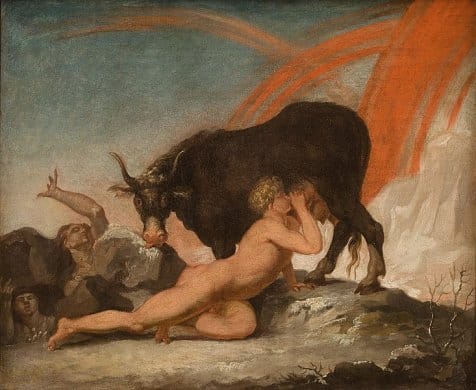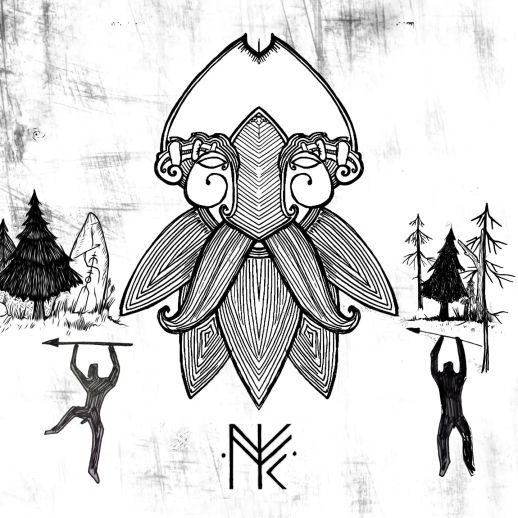According to the Norse creation myth, everything started in a large yawning gap in the cosmos called Ginnungagap. At one end was Niflheim with its plains of ice and icy rivers flowing out into the void. However, as the ice drew closer to the fiery realm of Muspelheim on the other end of the cosmos it melted. Out of this world of fire and ice came Buri, first of the Aesir gods.
Buri, whose name in Old Norse, Búri, means “producer” or “father”, will have a son named Borr who later goes on to have three sons. They are Odin, ruler of all the Aesir gods and his brothers, Vili and Ve whom creates Midgard with Odin. Thus all Aesir gods descend from him.
Norse mythology is a treasure trove of fascinating stories and multifaceted characters. In this post I will delve into the story of the two primordial gods, Buri and his son Borr. They are instrumental in laying the groundwork for the Nordic gods that will come later. As the first of the gods that would follow, their stories are forever linked to the larger narrative of Norse mythology.
Buri – The First God and Father to the Aesir
In the vast landscape of Norse mythology, the story of Buri begins with his creation from the ice of Niflheim. However, he isn’t the first being to live on the icy plains, he followed the giant Ymir, first of the jotnar, and the primordial cow Audhumla. Moreover, it is Audhumlas’ licking of the ice for sustenance that gradually sees Buri emerge from the ice. Ymir is already there, living off the milk flowing from Audhumla.

Little is told about what was going on between Ymir and Buri in the beginning of time. Were they friendly, or was there tension and strife between the two races even then? According to Snorri Sturlusons’ Gylfaginning, part two of the Prose Edda, there was perhaps an immediate tension between the races which would last through their shared history.
Buri’s status as the progenitor of the Norse gods and the patriarch of the divine lineage, including Odin, Vili, and Ve, makes him a pivotal figure in Norse mythology. His emergence from the ice of Niflheim sets the stage for the subsequent generations of gods, whose stories intertwine to form the intricate tapestry of Nordic myths.
Attestations of Buri and Borr in the old texts
Buri and Borr are mentioned in chapter four of the Gylfaginning part of the Prose Edda. Written by Snorri Sturluson in the 13th century, The Prose Edda is in part based on the collection of poems called the Poetic Edda.
In Gylfaginning, the Swedish king Gylfi, in the guise of Ganglere is asking Odin, himself disguised as three kings of Asgard, about the gods and their stories. The dialogue spans the whole of the Norse mythology from beginning to the fiery end at Ragnarök.
Gylfaginning chapter four, on the emergence of Buri and later birth of Borr.
“Thereupon asked Ganglere: On what did the cow subsist? Answered Har: She licked the salt-stones that were covered with rime, and the first day that she licked the stones there came out of them in the evening a man’s hair, the second day a man’s head, and the third day the whole man was there.
This man’s name was Buri; he was fair of face, great and mighty, and he begat a son whose name was Bor. This Bor married a woman whose name was Bestla, the daughter of the giant Bolthorn; they had three sons,—the one hight Odin, the other Vile, and the third Ve.”
Borr – Son of Buri and Father to Odin

Since Buri had no consort to have children with, he fathered his son Borr through parthenogenesis. However, while the Gylfaginning describes how Ymir fathered the giants, nothing is known about how Borr came to be.
He is the second generation of what will grow into the Aesir gods, and as such he is central to the continuation of the Nordic pantheon and the ongoing development of the cosmos. His story is deeply intertwined with that of his father and the larger narrative of Norse mythology.
By the time Borr comes into being, several generations of jotnar have also come to be. One of these descendants of Ymir is the giantess Bestla. She is said to be the daughter of Bolthorn, a Jötun and son of Bergelmir, grandson of Ymir.
The Union of Borr and Bestla
Borr’s union with Bestla, giantess and descendant of the frost giant Ymir, produced three sons: Odin, Vili, and Ve. They would later go on to slay Ymir, and then create Midgard, the earth, from his corps. Born of a divine and giant parentage, these offspring were half jötun, bridging the gap between gods and giants. Borr’s lineage, with its diverse connections to both gods and giants, is essential in shaping the Norse mythology we are familiar with today. The complex relationships forged through their divine and giant bloodlines create a rich tapestry of stories core to the mythology.
This really goes to the core of what I think is one of the most intriguing facets of Norse mythology. The gods and the jotnar are arch enemies, yet they are all descendants of Bestla, great-great-granddaughter of Ymir, the primordial Jötun.
The mixing of races at the beginning only lays the groundwork for all the later Aesir-Jötun relationships to come. Skadi and Njord, Thor and Järnsaxa and Freyr and Gerdr are a few examples and then Odin had both fleeting and long relationships with a number of giantesses. Jord and Rindr, mother to Vali, slayer of Hodr, are but a few of Odins’ giantess consorts.
Play Fun Norse Quiz
Is this article making you even more curious about Norse gods and goddesses? You can satisfy your curiosity by playing a fun Norse mythology quiz. This way, you can test your knowledge about Norse gods and goddesses, as well as fill in some gaps. Good luck and have fun playing!
Don’t forget to try our other games as well!
The legacy of Buri and Borr
The legacies of Buri and Borr extend beyond their own stories and permeate the entire corpus of Norse mythology. As the earliest gods in Norse mythology, they are the very foundation of the gods and myths to come. The subsequent generations of gods, are all deeply connected to the primordial pair of Buri and Borr.
Their tales, while not as widely known as those of their descendants, provide a valuable lens through which to view the larger narrative of Norse mythology. The ancient gods Buri and Borr not only gave rise to the Nordic pantheon. They also played a critical role in shaping the cosmos and setting the stage for the countless stories to follow.
FAQs about Buri about Borr
Buri is the first primordial god in Norse mythology, created from the ice of Niflheim. He is considered the progenitor (the first) of the Norse gods.
Buri came into existence as a result of the cow Audhumla licking the ice of Niflheim for sustenance.
Borr is the son of Buri and plays a crucial role in continuing the Nordic pantheon. He later fathers Odin and his brothers, the creators of Midgard.
Borr married Bestla, a giantess and a descendant of Ymir. They then had three sons: Odin, Vili, and Ve. Half jötun by birth, they play significant roles in Norse mythology to put it mildly.
Buri and Borr differ in their origins and relationships with other gods and goddesses. While Buri emerged from the ice of Niflheim, Borr was born (somehow) as Buri’s son.
Buri and Borr are important as the first two generations of gods and set the foundation for the Norse pantheon. With Borr’s marriage to Bestla and the birth of their sons expanding the divine lineage.
Featured Image Credit: Wikimedia Commons
